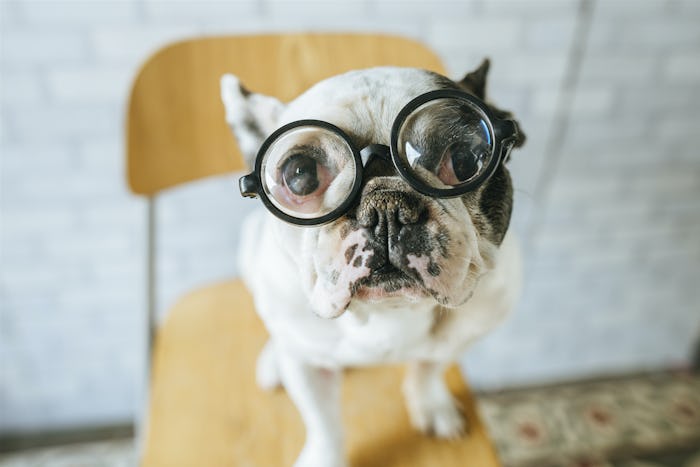Life

Just because dogs can't talk (in a way we understand them) doesn't mean they don't communicate, as every dog owner knows. In fact, if you've got a faithful furry companion, you probably know what they're thinking a good portion of the time. Of course, there's no way you can really say for sure what's going on in your pup's head — or can you? What is your dog's brain like, according to science? Thanks to the ever-expanding realm of canine brain research, there's more info than ever out there about how this beloved pet's mind actually works.
These creatures have a lot more going on than some might expect (though real dog lovers already know how shockingly smart our furry little and big friends can be). In some ways, they're not all that different from us (and, again, real dog lovers already know that, too).
From their complex emotional reactions to their highly evolved instincts, it's easy to see why dogs mean so much to their two-legged family members. No, they don't have opposable thumbs and, no, they'll never believe that shoes are not for chewing, but they still have as much personality and heart as any of your non-canine loved ones. And the more you know about how your dog's brain really works, the better your relationship will be.
1
Your Dog's Brain Is Like An Alarm Clock
You've likely witnessed the phenomenon of your dog jumping up from a sound snooze to look out the window and pace around restlessly, mere moments before your kids get home from school or your partner gets home from work. As an article on canine brain research in TIME reported, this seemingly psychic behavior suggests that dogs have both an awareness of the past and the future, as well as the rate at which time passes:
"Closed-circuit cameras show that they seem to prepare as the time comes for humans who have been out all day to return, stirring from a nap, checking the front door, becoming restless and excited."
With an internal clock like that, you'd never need to set your alarm again.
2
Your Dog's Brain Is Like A Guilt Trip Waiting To Happen
You know all those cute/sad viral videos of guilty-looking dogs trying to disappear into the corner as their owner shames them for ripping the stuffing out of the couch cushions or stealing a pastrami sandwich off the kitchen counter? It turns out that dogs will make a "guilty" face even when they're completely innocent, as Barnard College dog cognition expert Alexandra Horowitz tells Discover Magazine.
Horowitz set up an experiment in which owners were "misinformed about whether their dogs had eaten a forbidden treat," and, consequently, scolded their (in fact blameless) pets. Guess what? They still made the guilty face.
“What looks like a guilty look in dogs is actually prompted by human scolding,” Horowitz says. That doesn't mean dogs can't feel guilty, just that they'll be just as upset by you thinking they did something wrong (even if they didn't).
3
Your Dog's Brain Is Like Facial Recognition Software
Some people like to say they "never forget a face," but in the case of dogs, that claim is actually true. As Dr. Gregory Berns, a neuroscientist and the author of What It's Like to Be a Dog, tells The New York Times: "We’ve learned by showing pictures of objects and people to the dogs is that they have dedicated parts of their brain for processing faces. So dogs are in many ways wired to process faces."
So dogs aren’t just learning from being around people that human faces are important — they're actually born to pay attention to faces.
4
Your Dog's Brain Is Like A Game of Memory
If you've ever watched a preschooler puzzle over the placement of matching cards in a memory game, you'll understand the cognitive process that dogs are also capable of mastering. As TIME reports, in a 2013 study, behavioral psychologist Thomas Zentall of the University of Kentucky conducted a fascinating experiment:
"When a dog biscuit or other item of interest was carried behind a barrier and then carried back out, the dogs would give it a glance as it reappeared. But if it was secretly replaced by a larger or smaller version of the same object or one that had changed in color, they would stare much longer. The conclusion: a two-inch dog biscuit should remain two inches and a yellow ball should remain yellow, and dogs understand that."
So dogs not only understand the concept of object permanence, but also the defining characteristics of those objects. Pretty amazing!
5
Your Dog's Brain Is Like An Attention-Starved Extrovert
Can't go five minutes without your dog dropping a ball at your feet or trying to climb into your lap? You should know that he can't help constantly begging for attention. As Oregon State University animal behaviorist Monique Udell and her colleagues discovered, dogs’ need for interaction with their humans "may be coded in their DNA," according to Discovery Magazine. That's because, as Udell's research found, dogs have some of the same genetic characteristics as humans with Williams-Beuren syndrome, a "disorder marked by unusually extroverted personalities, lack of fear of strangers, and difficulty solving independent problems."
Interestingly, wolves don't share those same genetic traits, which could be why even wolves who've been socialized by people aren't as affectionate as dogs.
No wonder wolves never really took off as pets!
Check out Romper's new video series, Bearing The Motherload, where disagreeing parents from different sides of an issue sit down with a mediator and talk about how to support (and not judge) each other’s parenting perspectives. New episodes air Mondays on Facebook.